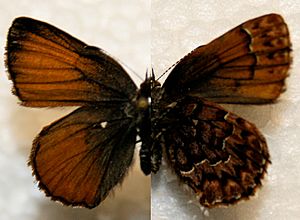Western pine elfin facts for kids
Quick facts for kids Western pine elfin |
|
|---|---|
 |
|
| Scientific classification |
The western pine elfin (Callophrys eryphon) is a small butterfly found in North America. It lives across a large area, from British Columbia in the west, all the way east to Maine, and south into California, Arizona, and New Mexico.
Male western pine elfins are brown, while females are orange-brown. Both have cool patterns on their back wings. The top of their wings has dark stripes with lighter, V-shaped edges. These butterflies are about 19 to 32 millimeters long and do not have tails.
Contents
Where They Live and What They Eat
You can find western pine elfins in natural pine woods and evergreen forests. They like areas with lots of pine trees. In the northwest United States, they often make their homes in lodgepole pines.
These butterflies are usually seen close to their natural habitat. They often perch on shrubs and smaller trees. They do this to look for food or to find a mate. Western pine elfins drink nectar from flowers. Their favorite foods include wild blueberries, milkweed, and clover.
Life Cycle and Reproduction
Adult western pine elfins come out in early spring. This is usually from March to June. They have one flight period each year. The female butterfly lays her eggs at the bottom of new pine needles. They only have one group of babies, called a brood, each year.
The caterpillars of the western pine elfin grow to be about 15 millimeters long. Their heads are green. Their bodies are a soft, velvety green with cream or yellow stripes. They also have fine hairs covering their bodies.
These caterpillars are a type of insect that eats leaves. They feed on young pine needles. They keep eating until late July or August. Then, they go into a resting stage called hibernation.
Conservation Status
The western pine elfin butterfly does not have many animals that hunt it. Because of this, it is considered a very safe species. There are no big threats to its survival around the world.
Images for kids


